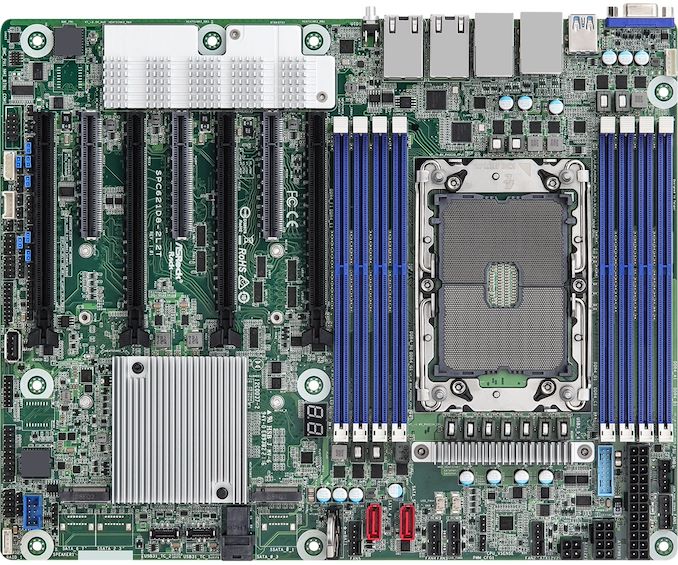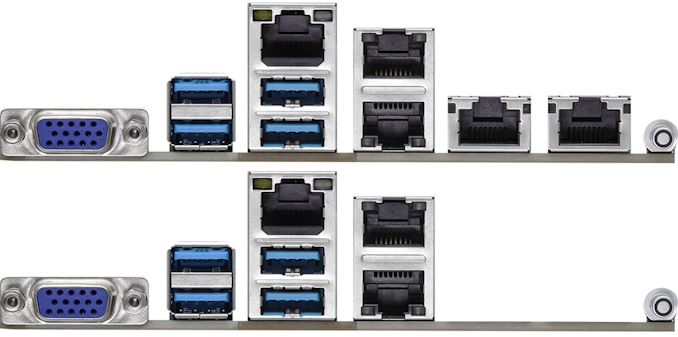ASRock Rack Announces Two ATX Ice Lake SP Motherboards
by Gavin Bonshor on August 3, 2021 9:00 AM EST_678x452.jpg)
ASRock Rack has unveiled two new motherboards designed for Intel's Ice Lake SP platform, the SPC621D8 and the SPC621D8-2L2T. Both boards feature a single LGA4189 socket design on an ATX-sized PCB, with eight memory slots supporting up to 2 TB of DDR4-3200 memory, seven PCIe 4.0 slots, and dual PCIe 3.0 M.2 slots. The SPC621D8-2L2T also gets five Ethernet ports, including dual 10 Gb Ethernet on the rear panel.
On the surface, both the ASRock Rack SPC621D8-2L2T and the SPC621D8 share the same core feature set, which includes four full-length PCIe 4.0 x16 slots and three half-length PCIe 4.0 x8 slots. Three of the full-length slots will automatically switch down to PCIe 4.0 x8 when the lower half-length slot is populated. Sitting on either side of the transposed LGA4189 socket are eight memory slots that are arranged into two banks of four. These slots can support up to 2 TB of DDR4-3200 memory, in the form of RDIMMs and LRDIMMs.

The ASRock Rack SPC621D8-2L2T motherboard
The ASRock Rack SPC621D8-2L2T and the SPC621D8 both include a varied selection of storage options, including one PCIe 3.0 x4/SATA M.2 slot and one PCIe 3.0 x1/SATA M.2 slot. The SPC621D8 has support for up to thirteen SATA ports, with six 7-pin headers included from the C621A chipset with support for RAID 0, 1, 5, and 10 arrays. The SPC621D8-2L2T has support for eight SATA ports, with the same level of RAID support. Both models include two SATA DOM headers and also include a mini-SAS HD header.
Driving the management side of things is an ASPEED AST2500 BMC controller. This can be accessed via a single D-sub video output or a dedicated management Ethernet port hooked up to a Realtek RTL8211E Gigabit controller. Both variants include various headers around the board, with some of the most notable which include a TPM header, COM header, PMBus connector, and an IPMB header. There are five 6-pin fan headers for cooling, one 24-pin 12 V ATX power input that provides power to the motherboard, and one 8-pin and one 4-pin 12 V ATX CPU power input pairing.

The ASRock SPC621D8-2L2T (top) and SPC621D8 (bottom) rear panels
Both boards share a similar rear panel layout, but with one major difference. The ASRock Rack SPC621D8-2L2T includes dual 10 GbE via an Intel X710-AT2 Ethernet controller, which is on top of the two Intel I210 Gigabit controllers and the Realtek RTL8211E management LAN port that are common to both boards. Both panels include a D-sub video output for the BMC, four USB 3.2 G1 Type-A ports, and a UID indicator LED button.
We don't have pricing for either the SPC621D8-2L2T or the SPC621D8 ATX motherboards or when they will hit retail shelves at the time of writing.
Source: ASRock Rack
Related Reading
- ASRock Unveils C621A WS Motherboard, Designed for Xeon W-3300 Workstations
- Intel Launches Xeon W-3300: Ice Lake for Workstations, up to 38 Cores
- Intel 3rd Gen Xeon Scalable (Ice Lake SP) Review: Generationally Big, Competitively Small
- GIGABYTE Server: Three New E-ATX Motherboards For Intel Ice Lake-SP Xeons


_thumb.jpg)
_thumb.jpg)
_thumb.jpg)
_thumb.jpg)
_thumb.jpg)
_thumb.jpg)








5 Comments
View All Comments
DReGPU - Tuesday, August 3, 2021 - link
I guess that's a FU to people that want to populate that last PCIe slot with a GPU accelerator, long RAID card, or anything that's so short it doesn't collide with that USB port. The Gigabyte WRX80 has this, and it really makes no sense to place it there. https://imgur.com/a/R2jF9Vqwatersb - Tuesday, August 3, 2021 - link
With all the headers on the bottom of the board, unlikely to fit a GPU in there anyway, I think. I'd use it for a storage or network controller... although I'm not yet used to PCIe 4.0 x16 bandwidth. The fastest I/O I've ever used is 40Gb Thunderbolt.zer0sum - Thursday, August 5, 2021 - link
You should be using SATA DOM's anyways :Pezekiel68 - Sunday, September 19, 2021 - link
I own a recent AMD server MB from ASRock Rack and on that board, the ASPEED AST2500 serves as the BMC controller AND as a general I/O chip as well. It drives the rear RS-232 COM port as well as the D-sub VGA connector which definitely provides general on-board video for the BIOS and the OS (once installed). In the User Manual for my MB, there is no way to access the BMC via the VGA port, even though they both have the ASPEED controller chip in common. Instead, the managment LAN port must be connected to a network. Then, a separate device on the same network can accesses the IPMI application via a web browser, once the IP address of the server BMC is deduced (it may be set or viewed in the BIOS depending of whether you use DHCP, which is the default).The D-sub port merely provides general "video out" to a VGA monitor without the need for a separate video card. This allows one to use the server locally once an OS is installed or to access the BIOS locally to (among other things) configure initial settings for the BMC, such as static or DCHP networking, etc.
dailyprimenews - Tuesday, December 28, 2021 - link
https://thereliablenews.com/https://thereliablenews.com/sports/
https://thereliablenews.com/entertainment/